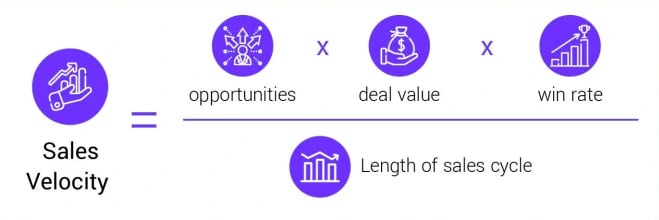
Markus Stahlberg
~2 min
Sales Velocity: A Metric That Helps You Sell More And Faster
Stock markets are going down, demonstrating the worst results in nearly 14 years. Inflation and interest rates are going up. This is going to cause problems in the market globally and for individual companies.
For commercial teams like sales and marketing, this will most likely result in:
– Less inbound opportunities. Businesses will be less interested in finding new tools and resources to invest in.
– Lower conversion for outbound opportunities. Service and solution providers will rely on outbound techniques more to grow their pipeline, which will result in more competition and a lower outreach conversion rate.
– Longer sales cycles. Companies will need more time to evaluate if the investment is going to pay off. Contracts are going to go through more people within the company to be approved.
– Lower opportunity win rate. The longer and more complex the approval process becomes on the client side, the higher the chance that the contract with your company is going to be declined at any stage.
Working on sales velocity helps address all of these challenges.
Sales velocity explained
A deal took 35 days to close compared to an average of 24 days. Is it a good or a bad result?
You can’t really say it without looking at other metrics. If the paycheck was 3x higher than average, this is definitely a good deal.
Concentrating on one number won’t give you a complete picture. This is why complex processes, like the sales and marketing process, need to be analyzed through compound metrics. Sales velocity is one of those.
Sales velocity is a metric that allows you to understand how quickly and efficiently your business is making money. When you measure your company’s sales velocity, you understand how quickly the deals move through your pipeline and generate revenue.
Four parameters are crucial for the calculation:
1. Number of opportunities. How many opportunities do you currently have in your pipeline?
2. Average deal value. What is an average paycheck for a closed-won opportunity?
3. Win rate. How many opportunities close won in relation to the overall number of opportunities?
4. Sales cycle length. How long does it take a customer to move through the pipeline and convert?
Once you have this data ready, apply the following formula:

For example, you had 50 opportunities closed won, with an average deal size of $1000, an average win rate of 30%, and an average sales cycle length of 20 days.
Sales Velocity = (50 x $1000 x 0.3) / 20 = $750 per day (or $22 500 per month)
Why it's important to monitor
With this formula, you can see that even a small change in two or more variables has a compound effect on the overall result. Increasing the deal size and the win rate by 10% while shortening the sales cycle by 10% will give you a 34.4% increase in sales velocity:
Sales Velocity = (50 x $1100 x 0.33) / 18 = $1008 per day (or $30 240 per month)
You’ll never manage to estimate and embrace this compound effect without proper calculation.
Why it’s challenging to calculate
When it comes to an actual calculation and implementation, you can face several challenges:
1. You need to have data in place. If your CRM is a mess and the data is scattered across spreadsheets, it will take time to calculate everything properly. You’ll need to monitor four different metrics at the same time. If you were looking for motivation to reorganize your CRM and tracking process – you have it now!
2. You need to update it regularly. Sales velocity doesn’t make sense if calculated once and forgotten for months. A monthly update is required, in order to track the changes and react quickly. You can either add this task to your regular to-do list or rely on tools (like N.Rich) that calculate sales velocity automatically and provide a score for each of your accounts in CRM.

3. It needs to be actionable. “Our sales velocity has dropped this month”, says your sales director. What should happen next? How should sales and marketing teams act to improve it? In order to work effectively on every component, members of both teams should understand their areas of responsibility. Marketing needs to make sure that they use recent and updated target account lists for their advertising campaigns and generate enough engagement with their creatives. Sales need to make sure they prioritize accounts with high sales velocity and use insights provided by marketing (the topics and creatives the target accounts were mostly interested in, the locations they browse from, and the pages they clicked and visited).
Does working on sales velocity help reduce CAC?
Customer acquisition cost (CAC) is the amount of money a business spends to gain a new customer.
CAC = (cost of sales + cost of marketing) / number of new customers acquired
Sales velocity isn’t directly related to CAC. However, concentrating on prospects with higher sales velocity has a big influence on your customer acquisition cost:
1. You’ll generate more customers. Prospects with high sales velocity turn into clients faster.
2. You’ll spend your budget on those more likely to convert. Prospects with high sales velocity demonstrate a higher win rate.
3. You’ll spend your budget on clients with higher paychecks. The average deal size is higher for prospects with high sales velocity. CAC doesn’t take this into account directly, but if you generate deals with higher average value, this will help prove that your acquisition strategy is moving in the right direction.